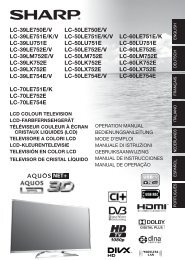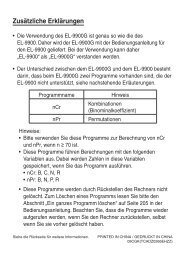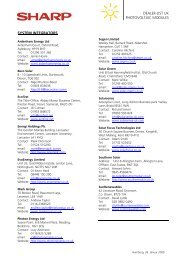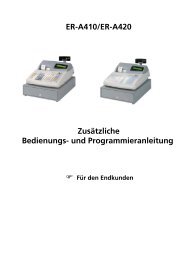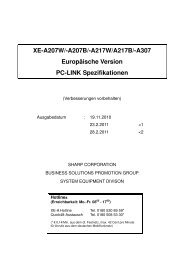r-24st / r-2b34 microwave oven operation manual with cookbook
r-24st / r-2b34 microwave oven operation manual with cookbook
r-24st / r-2b34 microwave oven operation manual with cookbook
You also want an ePaper? Increase the reach of your titles
YUMPU automatically turns print PDFs into web optimized ePapers that Google loves.
R-24ST/2B34 ENGLISH 28/3/01 10:00 am Page 22<br />
TIPS AND ADVICE<br />
TURNING/STIRRING<br />
Almost all foods have to be turned or stirred from time<br />
to time. As early as possible, separate parts which are<br />
stuck together and rearrange them.<br />
SMALL AMOUNTS<br />
Thaw more quickly and evenly than larger ones. We<br />
recommend that you freeze portions which are as<br />
small as possible. By so doing you will be able to<br />
prepare whole menus quickly and easily.<br />
FOODS REQUIRING CAREFUL HANDLING<br />
Foods such as gateaux, cream, cheese and bread<br />
should only be partially thawed and then left to thaw<br />
completely at room temperature. By so doing you will<br />
avoid the outer areas becoming too hot while the<br />
inside is still frozen.<br />
STANDING TIME<br />
This is particularly important after thawing food, as the<br />
thawing process continues during this period. In the<br />
thawing table you will find the standing times for<br />
various foods. Thick, dense foods require a longer<br />
standing time than thinner foods or food<br />
of a porous nature. If the food has not thawed<br />
sufficiently, you may continue thawing it in the<br />
<strong>microwave</strong> <strong>oven</strong> or lengthen the standing time<br />
accordingly. At the end of the standing time you<br />
should process the food as soon as possible and not refreeze<br />
it.<br />
COOKING FRESH VEGETABLES<br />
● When buying vegetables try to ensure that, as far<br />
as possible, they are of similar size. This is<br />
particularly important when you want to cook the<br />
vegetables whole (e.g. boiled potatoes).<br />
● Wash the vegetables before preparing them, clean<br />
them and only then weigh the required quantity for<br />
the recipe and chop them up.<br />
● Season them as you would normally, but as a rule<br />
only add salt after cooking.<br />
● Add about 5 tbsps of water for 500 g of<br />
vegetables. Vegetables which are high in fibre<br />
require a little more water. You will find information<br />
about this in the table.<br />
● Vegetables are usually cooked in a dish <strong>with</strong> a lid.<br />
Those <strong>with</strong> a high moisture content, e.g. onions or<br />
boiled potatoes, can be cooked in <strong>microwave</strong> foil<br />
<strong>with</strong>out adding water.<br />
● After half the cooking time has elapsed vegetables<br />
22<br />
should be stirred or turned over.<br />
● After cooking allow the vegetables to stand for<br />
approx. 2 minutes, so that the temperature<br />
disperses evenly (standing time).<br />
● The cooking times given are guidelines and depend<br />
upon the weight, initial temperature and condition<br />
of the type of vegetable in question. The fresher the<br />
vegetables, the shorter the cooking times.<br />
COOKING MEAT, FISH AND POULTRY<br />
● When buying food items, try to ensure that, as far<br />
as possible, they are of similar size. This will ensure<br />
that they are cooked properly.<br />
● Before preparation wash meat, fish and poultry<br />
thoroughly under cold running water and pat them<br />
dry <strong>with</strong> kitchen paper. Then continue as normal.<br />
● Beef should be well hung and have little gristle.<br />
● Even though the pieces may be of a similar size,<br />
cooking results may vary. This is due, amongst<br />
other things, to the kind of food, variations in the fat<br />
and moisture content as well as the temperature<br />
before cooking.<br />
● After the food has been cooking for 15 minutes it<br />
acquires a natural brownness, which may be<br />
enhanced by the use of a browning agent. If, in<br />
addition, you would like the surface to be crisp you<br />
should either use the browning dish or sear the food<br />
on your cooker and finish cooking it in your<br />
<strong>microwave</strong>. By doing this you will simultaneously<br />
obtain a brown base for making a sauce.<br />
● Turn large pieces of meat, fish or poultry half way<br />
through the cooking time, so that they are cooked<br />
evenly from all sides.<br />
● After cooking cover roasts <strong>with</strong> aluminium foil and<br />
allow them to stand for approx. 10 minutes (standing<br />
time). During this period the roast carries on cooking<br />
and the liquid is evenly distributed, so that when it is<br />
carved a minimum amount of juice is lost.<br />
THAWING AND COOKING<br />
Deep-frozen dishes can be thawed and cooked at the<br />
same time in one process in your <strong>microwave</strong>. You will<br />
find some examples in the table. Do take note,<br />
however, of the general advice given on "heating" and<br />
"thawing" food. Please refer to the manufacturer's<br />
instructions on the packaging when preparing deepfrozen<br />
dishes. These usually contain precise cooking<br />
times and offer advice on preparation.



